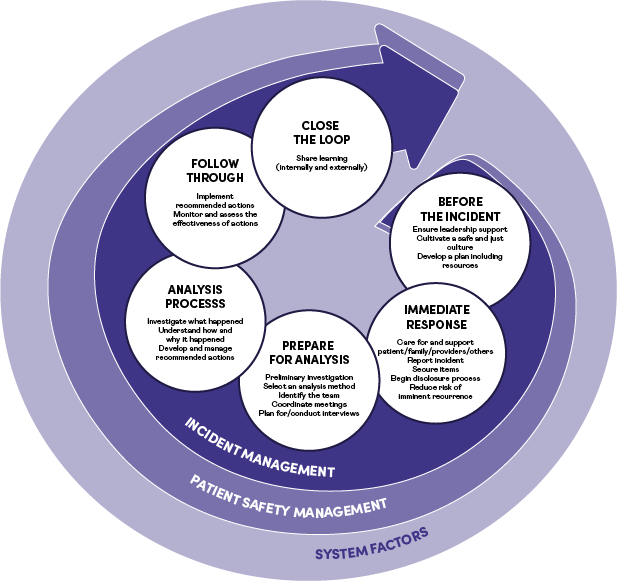Developed from the best available evidence and expert advice, this toolkit is for people responsible for managing patient safety, quality improvement, risk management and staff training in any healthcare setting.
For more information, contact us at info@hec-esc.ca.
What This Toolkit Covers
While patient safety and incident management are the main focus, in the toolkit you will also find some ideas and resources for exploring the broader aspects of quality improvement and risk management.
The toolkit covers three sections (as represented in the image below):
Patient safety management: the actions that help to proactively anticipate patient safety incidents and prevent them from occurring. In this section, the resources guide you in planning, anticipating and monitoring your response to expected and unexpected safety issues, for safer care today and in the future. We promote a patient safety culture and reporting and learning system.
Incident management: the actions taken after patient safety incidents (including near misses). This section offers guidance and resources to support the immediate response, disclosure, preparing for analysis, the analysis process, follow-through, and closing the loop and sharing learning.
System factors: the factors that shape and are shaped by patient safety and incident management. They originate from different system levels (inside and outside the organization) and include legislation, policies, culture, people, processes and resources. This section helps you to understand these factors and identify ways to respond to, align with and leverage them to best support patient safety.

Guiding Principles for Safe Patient Care
When implementing the toolkit’s practical strategies and resources, keep in mind these guiding principles:
- Patient- and family-centred care. Patients and their families are at the centre of all patient safety and incident management activities. Engage with them as equal partners throughout their care processes; they are essential to the design, implementation and evaluation of care and services.
- Safety culture. Culture refers to shared values (what is important) and beliefs (what is held to be true) that interact with a system's structures and control mechanisms to produce behavioural norms. Nurturing a safety culture helps avoid, prevent and mitigate patient safety risks at all levels. Reporting and learning cultures are integral components of the overall safety culture.
- System perspective. Keep patients safe by understanding and addressing the factors that contribute to an incident at all system levels, redesigning systems and applying human factor principles. Develop the capability and capacity for effectively assessing the complex system to accurately identify weaknesses and strengths for preventing future incidents.
- Shared responsibilities. Teamwork is necessary for safe patient care, particularly at transitions in care. It is the best defence against system failures and should be actively fostered by all team members, including patients and families. In a functional teamwork environment, everyone is valued, empowered and responsible for taking action to prevent patient safety incidents, including speaking up when they see practices that endanger safety.
Resources
The practical resources in this toolkit aim to support patient safety and incident management, which we compiled with input from experts and contributing organizations. As patients, organizations and situations will differ, you will need to use your discretion to select the tools most appropriate for your needs.
Toolkit Development and Maintenance
A variety of qualified experts and organizations worked with the Canadian Patient Safety Institute (now Healthcare Excellence Canada) to compile this practical and evidence-based toolkit. The process included:
- assigning an inhouse team with support from a writer with experience in the field
- seeking advice from an expert faculty that included patient and family representatives
- basing the content on the Canadian Incident Analysis Framework
- engaging key stakeholders via focus groups and collecting evidence from peer-reviewed journals and publicly available literature
We welcome feedback on what is helpful, what can be improved and content enhancements at info@hec-esc.ca.
